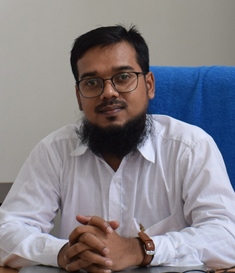Latest Articles
Original Research Article
ABSTRACT
Digital pedagogy has become an essential tool in the education sector, offering opportunities to enhance student engagement, creativity, and access to knowledge. This study has investigated the use of digital pedagogy in teacher education programmes, focusing on its potential to boost learning motivation among prospective teachers, thereby creating more dynamic and personalized learning environments. The study has analysed digital pedagogy and teacher education documents, emphasizing its growing importance for adapting to technological advancements, enhancing learning opportunities, supporting personalized learning, developing digital literacy, preparing educators for remote teaching, and promoting global learning. The findings of the study have been disclosed that digital pedagogy significantly enhances learning motivation among prospective teachers by offering engaging, flexible, and meaningful learning experiences. Interactive tools such as gamification, virtual simulations, and collaborative platforms allow learners to actively participate and experience the practical relevance of what they are studying. Personalized learning paths, access to diverse resources, real-time feedback, and innovation and creativity support both professional growth and student engagement. Digital pedagogy can transform teacher education by fostering motivation and innovative teaching approaches. However, challenges include unequal access to technology, lack of digital literacy, inadequate support, and challenging assessments. A balanced approach, including technology investment, professional development, and self-directed learning can prepare future educators.
ABSTRACT
Inclusive and equitable quality education for all have being a major concern for countries around the world, as it is capture as part of the year 2030 agenda for sustainable development, specifically in sustainable development goal 4. While international organizations and governments around the world have been making effort in promoting and enhancing literacy among citizens including adults, however, literacy rate among adult populations in most developing countries including Nigeria seems alarming, as considerable portion of Nigeria’s adult population, especially those residing within the rural areas finds it difficult to read, write and do simple arithmetic operations. High level of illiteracy results in poor employment opportunities as well as low income, low self-esteem and higher crime rates. While crime is an inevitable occurrence in societies, prisons exist to protect societies from criminals as well as deviants, whose actions portend threats to societal functioning. Although, prisons are mainly established for protecting societies; reformation and rehabilitation of the convicted prisoners are key functions of all correctional institutions, and education plays crucial role in the rehabilitation process. Thus, this study advocates the inclusion of adult education programmes such as peace education, adult literacy, environmental adult education, civic and political education in Nigerian correctional institutions, as a way of minimizing high incidences of recidivism, as well as ensuring pro-social attitudes and behaviours required from prisons’ inmates, after serving jail terms. The requisite knowledge in adult education programmes, becomes a source of potential benefits to community sustainability, as ex-prisons’ inmates can make effective contributions through knowledge acquired, in achieving the desired socio-economic and environmental sustainability in Nigerian communities.
ABSTRACT
This paper examined educational growth and its contribution to national development in Nigeria. The paper adopted review of literature to present the sequence of innovations in curriculum development and the evolving policies and programmes targeted at improving education and enhancing the achievement of national goals and national development. The paper identify different educational systems and programmes such as the introduction of Universal Primary Education UPE in 1976 and Universal Basic Education UBE in 2000, highlighting the achievements recorded from each of the programmes and the challenges which hinder its success. The challenges identified include, poor funding, poor implementation, lack of infrastructures, inadequate in-service training for teachers and inadequate qualified teachers among others. The authors also discuss the effectiveness of basic education in national development and thus suggest that Government should ensure complete implementation of the UBE programme by reviewing the policy document that established the programme and ensure full implementation. Government should employ qualified teachers to meet the growing population of the students, ensuring that appropriate student-teacher ratio are maintained at the basic schools.
ABSTRACT
Islam as a comprehensive way of life touches every aspect of human endeavours. This is with a view to providing him the guidance that will make him enjoy his worldly sojourn happily and in tranquillity, and also emerge successful in his eternal abode in the life Hereafter. Indeed, one of the unique features of Islam in its divine laws is the principle of inheritance. No other religion in the world other than Islam provides a comprehensive explanation of who is to inherit who and who is not, and what portions are to be inherited, and who can prevent who from inheriting the deceased’s property. It is against this background that this paper provides a clear exposition on the doctrine of exclusion in the Islamic law of inheritance, under which a clear determination has been provided on who is to exclude who among heirs from inheriting the estate of the dead person. The paper also extols the beauty of such blockage in the principles of Islamic law of inheritance. One of the findings of the paper is that the doctrine of exclusion is based on the blood relationship ties between the dead and the surviving relations.
Original Research Article
ABSTRACT
Makala hii inahusu mbinu zilizotumika kuunda motifu za safari na msako katika mashairi ya Kiswahili katika diwani ya Sauti ya Dhiki (1973) ya Abdilatif Abdalla. Makala hii inalenga kuiziba pengo la kiutafiti juu ya mbinu zinazounda motifu, kwani hakuna tafiti zilizofanyika kubainisha mbinu zinazounda motifu za safari na msako katika Ushairi. Katika uga wa fasihi baadhi ya wataalamu wamechambua mbinu mbalimbali za kisanaa zinazounda kazi za fasihi kwa ujumla, na wale walioangalia muundo wa motifu katika kazi za fasihi walibaini hisia ndio kichocheo kikuu kinachosababisha ujirudiajirudiaji wa kimotifu, hivyo basi hisia huunda motifu. Ushairi wa kimaelezo ni miongoni mwa kazi za fasihi zilizo na motifu za safari na msako na zinaundwa kwa miundo bayana. Licha ya tafiti mbalimbali kubaini kwamba motifu hizo zinajitokeza zaidi katika ushairi simulizi na ule wa kidrama. Ombwe la tafiti juu ya mbinu zinazotumika kuunda motifu za safari na msako limekuwa bayana hususani katika mashairi ya kimaelezo. Hali hii ikiachwa bila kuchunguzwa inasababisha kukosekana kwa maarifa kuhusu mbinu zinazotumika kuunda motifu hususani motifu za safari na msako katika mashairi ya kimaelezo. Mashairi ya kimaelezo yaliyorejelewa ni yale yanayopatikana katika diwani ya Sauti ya Dhiki (1973) ya Abdilatif Abdalla. Data za Makala hii zilikusanywa kwa kutumia mbinu ya usomaji makini wa matini teule wa mashairi ya kimaelezo katika diwani teule. Nadharia za Mwingilianomatini na Ruwaza ya Shujaa ndizo zilizoongoza ukusanyaji na uchambuzi wa data za Makala hii kupitia misingi yake mbalimbali kama itakavyofafanuliwa katika Makala. Matokeo ya utafiti yanaonesha kuwa kuna mbinu tano zilizobainika kuunda motifu za safari na msako katika mashairi ya kimaelezo katika diwani teule. Mbinu hizo ni mbinu ya ruwaza, mbinu ya diolojia, mbinu ya shajara, mbinu ya kisitiari na mbinu ya sauti ya usimulizi.
Original Research Article
ABSTRACT
Objective: This article aims to analyze the relevance of clan strategies in the fight against Neglected Tropical Diseases (NTDs) in the Western region of Cameroon. Introduction: The abrupt cessation of mass distribution of Ivermectin for onchocerciasis control, due to the suspension of international funding in Cameroon, risks prolonging or undoing efforts made since the 2000s to eliminate onchocerciasis as a public health issue. To mitigate this, a strategy referred to as the "clan strategy" has been implemented. This strategy aims to empower families to manage their health issues, which have severe consequences on vision and skin. Methodology: This article is based on a descriptive and analytical study with a mixed approach (quantitative and qualitative), conducted from June to August 2025 in the health districts of Foumbot, Bamendjou, and Bangourain in the Western Region of Cameroon. Data collection for the analysis of performance indicators of the program was carried out using an Excel spreadsheet for the quantitative aspect, and semi-structured interviews and Focus Group Discussions (FGDs) for the qualitative part. The study was conducted in communities where this strategy has been implemented, involving District Health Chiefs, Health Area Chiefs, clan distributors, and 81 clan members (clan leaders, community representatives), as well as household heads in the communities. The aim was to assess their knowledge, participation, and perceptions regarding NTD-related activities. Results: Motivational challenges faced by distributors, treatment delays, absenteeism, and refusals were reduced due to the strong community ownership of the onchocerciasis control efforts, particularly in rural areas. The post-distribution coverage survey shows that 85% of the areas were adequately covered. The implementation of the clan strategy in the mass distribution of Ivermectin for onchocerciasis control serves as a viable alternative to the cessation of international funding for NT
ABSTRACT
The “human inner experience’ while inherently private and challenging to observe scientifically, is a central and fundamental feature of the human condition, essential for understanding well-being, identity, and consciousness.” The core characteristics of the inner experience is that it is private and subjective. Inner experiences are soon passing out of memory and people are often inaccurate in their retrospective descriptions of their inner experiences. Psychology is incomplete without exploring the mind’s inner works. In processes such as inner speech and verbal cues are used to sustain focused attention on tasks and impact on behavior and cognitive performance. The difficulty human inner experience presents is that, there is a gap between how people make choices based on description of outcome versus those based on direct, personal experience, a limitation in how humans process and translate information into genuine inner understanding. The philosophy inherent limitations of the subjectivity, embodiment, and the explanatory divide between physical processes and qualitative feelings. The mind-body problem where there is a gap in truly knowing what another person’s experience of something is like. The author of “the human inner experience” discusses the private, subjective, and dynamic aspects of consciousness, including thoughts, emotions, mental imagery, and sensations. The study touches upon the theoretical complexities, methodological challenges, and interdisciplinary approaches required to study it scientifically. Investigating this private domain presents profound challenges, as traditional introspective reports can be distorted by observation, interpretation, and memory biases. The method of approach used in the investigation of “the human inner experience” involves responding to questions such as these: Why am I this way? Feeling of inner emptiness; Attachment and detachment; How to see fear; why do we suffer; Viewing death; and Spiritual and psychoanalyt


















